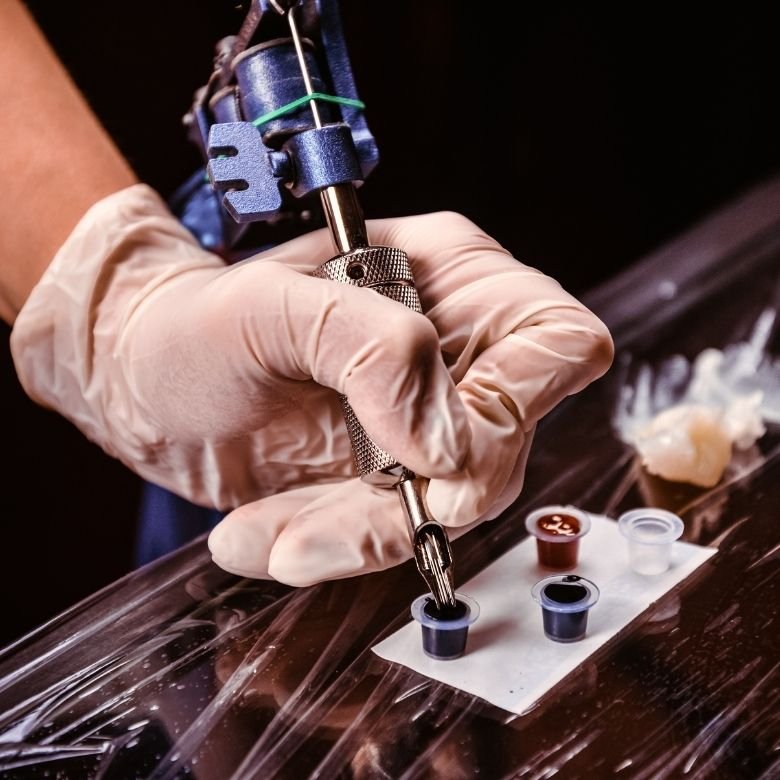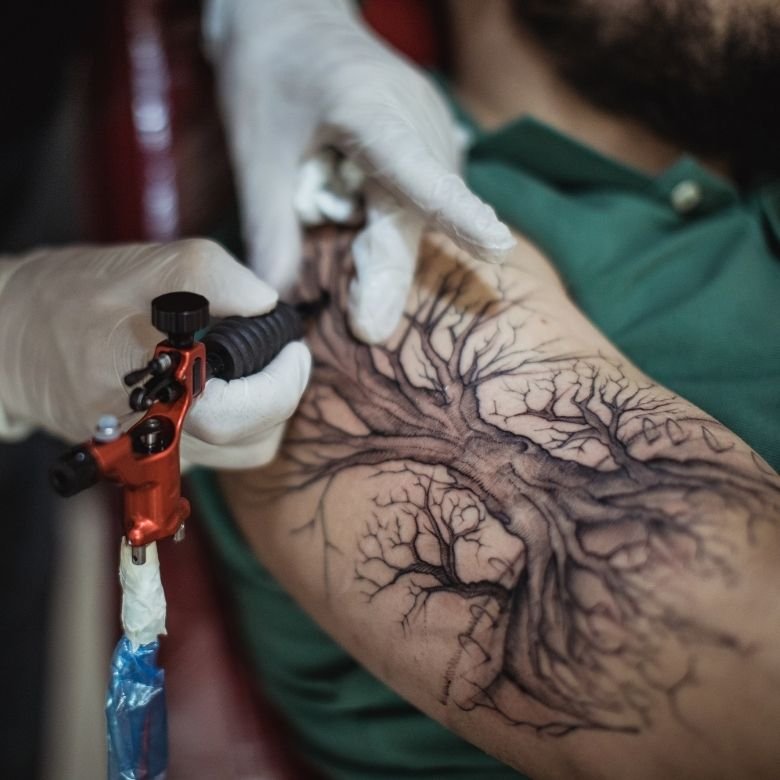The word tattoo (tatau) comes from Polynesia, meaning sign or painting. The history of tattooing is very long and goes back over 4,000 years. As early as the beginning of our civilization’s history, people introduced various dyes into the skin, thanks to which, patterns related mainly to rituals, were created.

Over time, however, the symbolism of the tattoo has taken on a completely different meaning. Today, tattooing is a form of visual art, through which you can communicate your feelings and beliefs, as well as culture and religion.
A tattoo can present a specific meaning that is important to its owner. It is also a fashion accessory that manifests a certain lifestyle or belonging to certain social groups.
The first preserved tattoos, composed of points and lines, were discovered in Egypt. They were found on the mummified body of the Egyptian priestess of Hathor. They are dated to 2200 BC. Ötzi – was a man who died around 3300 BC, whose mummified body was found in South Tyrol in 1991, had as many as 61 tattoos on his body.
Every year, tattoos gain more and more popularity, all over the world. Today, about 12% of the inhabitants of European countries have got a tattoo. If you carefully analyse people from the 18-35 age group, it could turn out that even twice as many may have a tattoo. In Germany, 16 million people already have a tattoo. In the United States, about 25-30% of people, between the ages of 18 and 50, have a drawing on their skin.
Permanent tattoo and permanent make-up durability
Tattoos are made by injecting a special ink into the dermis. This is made with a needle, thanks to which, even the most complex patterns can be reproduced on the skin. Permanent makeup (a cosmetic tattoo) is mainly used to achieve a permanent makeup effect. It allows you to improve and extend the durability of the colour of eyebrows, lips, the face and eyelids.
Both tattoos and permanent makeup are very durable forms of skin colouring. Pigments introduced under the skin are practically impossible to remove from the body, mainly due to particle size, as well as the type and composition of pigments.
The most popular method of tattoo removal today is laser treatment. It consists of breaking down the ink, with a laser beam. After a few such treatments, the pigment is gradually absorbed into the skin, making it more and more invisible.
Skin colouring inks – historical and contemporary times
History shows that the pigments used to make tattoo inks were once sourced from geological and mineral resources. An example of this is black ink that was produced from soot (carbon) and iron oxide. Red dye, on the other hand, was obtained thanks to the use of a mercury sulphide compound (cinnabar). Various shades of red, orange and yellow were made from cadmium compounds.
Today, the pigments in inks are based on organic and partly mineral components. As much as 80% of pigments are usually carbon-based, of which as much as 60% are azo (synthetic) dyes.

What ingredients do tattoo inks contain?
Tattoo inks are usually made of colour and the colour medium.
Colour is usually a popular pigment, which is a substance that gives a certain colour to another, colourless substance. Pigments are compounds that do not require an additional chemical reaction to give it a specific colour. Therefore, they are safer than ordinary dyes that need chemical or physical support to settle on the skin and permanently colour it, in a specific pattern.
The colour carrier is a substance that carries the pigment into the skin. The carrier may contain isopropyl alcohol, water, witch hazel or glycerine.
The inks also contain other chemical compounds, which include surfactants. A wide range of this type of raw material can be purchased directly from surfactant producers, including the PCC GROUP.
Before buying, it is also worth carefully analysing information about the products, checking their properties and verifying the technical documentation. We are dealing here with inks, i.e. substances that can affect human health and life. As for the surfactants from the PCC GROUP, this can be done on www.products.pcc.eu.
Tattoo inks also contain other components. These include: binders, preservatives, fillers and others. Many of these compounds are used to ensure the uniform consistency of the ink and to prevent the growth of micro-organisms.
Classic and cosmetic tattoo inks are often classified as preparations made of water-insoluble pigments composed of nanometer / micrometer particles and auxiliary substances, which include, for example, emulsifiers, solvents and preservatives.
A typical tattoo ink contains:
- pigments and other dyes (usually added in powder form)
- water,
- preservatives,
- surfactants: emulsifiers, wetting agents, viscosity regulators,
- solvents,
- binding substances.
The composition of the dyes
The most popular dyes that are the components of tattoo ink include compounds, such as: TiO2 (titanium dioxide), BaSO4 (barium sulphate), Fe3O4 (iron oxide, magnetite), FeO (iron oxide), HgS (mercury sulphide) or CdSe (cadmium selenide).
Organic compounds contained in inks are divided into polycyclic compounds and azo compounds. Azo dyes are substances that can break down in the body. This results in the production of amines that are harmful to health.
The dyes contained in inks often contain a number of heavy metals, such as lead, cadmium, mercury, arsenic and others. In addition to heavy metals, dyes may also contain phthalates, nanoparticles and hydrocarbons.

Can a tattoo be harmful to health?
Classic and cosmetic tattoo inks are a mixture of several chemical compounds. Some of them may turn out to be dangerous, causing various reactions (e.g. allergies) of the body that have a more serious impact on human life and health.
Pursuant to the Regulation of the European Commission, Tattoo-REACH, many of the ingredients for the production of tattoo inks are currently prohibited in EU countries. This Regulation has been in force since January 4th, 2022.
Therefore, tattoo lovers should use the services of professional salons, which use only inks approved for use in the European Union.
Body marbling – an alternative to a tattoo?
Body marbling can undoubtedly be a very good alternative to tattooing. What is this modern method of body decoration?
Body marbling is an increasingly popular trend that provides a great alternative to a permanent tattoo. It is based on the non-invasive application of colourful patterns on different parts of the body. This method of skin decoration has been known in China for centuries.
So, what does the process of applying paint on the body surface look like?
The carrier in the body marbling process is water, in which surfactants (lowering the surface tension of the liquid) are dissolved. The solution, prepared in this way, should be placed in a deep vessel, and then acrylic paints, that are safe for the skin, should be put into it.
Before applying the paint, the skin surface should be thoroughly cleaned of sebum and other impurities. The paint is applied by immersing the appropriate part of the body in a previously prepared bath. There is acrylic paint on its surface, which will remain on the skin, creating original, irregular patterns. After applying the paint, it is necessary to dry the skin covered with paint thoroughly, with a stream of air.
Different paints are used to make body marbling. Their advantage is their safety of use. They do not usually cause allergies or other skin irritations. Skin covered with bright, neon colours, as well as fluorescent paints, create an amazing effect. An important feature of body marbling paints is that they are easy to remove. It is easy to wash off such paint with soapy water or makeup liquid.

Interesting facts about tattoos
- The man whose body is 99.9% tattooed is Gregory Paul McLaren aka Lucky Diamond Rich. He was born in 1971. He started his tattoo adventure at the age of 16.
- American Samuel O’Reilly is a man to whom we owe the invention of the first electric tattoo device. Mr O’Reilly presented his modern device in 1891.
- The inhabitants of Europe became interested in the art of tattooing in the 18th century, thanks to a man from Tahiti, whom the explorer James Cook took with him to the country. This man wore wonderful, permanently made patterns and drawings on his body.
- Dragon tattoos were once extremely popular in Eastern cultures. Their goal was to protect against evil spirits and sea monsters.
- Tattoos are also great advertising media. Billy Gibby is a boy who has 22 advertisements of famous brands tattooed on his body. 10 of them are on his head. In this way, he wants to draw attention to the need to donate organs and blood, in order to save people’s lives.
- George Ranger is an American who loves Disney fairy tales and tattoos. The man combined these passions by being the happy owner of 500 fairy-tale characters. On his body, for example, there is a drawing of Aladdin, the Little Mermaid and 101 Dalmatians.
- Famous personalities, such as: Albert Einstein, Joseph Stalin, Catherine II and Peter I also had tattoos. Nicholas II, for example, had a tattoo of a dragon, a sword and his wife’s name.
- The most spectacular and most expensive tattoo in the world is a pattern made of real diamonds! Its creation required 612 diamonds of 5 carats each. The cost of such a tattoo is USD 324,000.
Sources:
https://echa.europa.eu/pl/hot-topics/tattoo-inks
https://tattoo-witryna.pl/2019/10/28/15-faktow-na-temat-tatuazu/
https://cowboytattoo.com/pl/tusz-do-tatuazu-chemia-tuszu-do-tatuazu/
https://www.greelane.com/pl/nauka-tech-math/nauka/tattoo-ink-chemistry-606170/
http://analit.agh.edu.pl/wp-content/uploads/2018/05/20_Skawinska_Klaudia_Analit_5.pdf
https://kwartalnikchemiczny.pl/archiwum/2016/item/24-tusze-i-farby-do-tatuazy-i-makijazu-permanentnego
https://www.teenvogue.com/story/body-marbling-temporary-tattoo-trend
https://noizz.pl/lifestyle/body-marbling-co-to-jest/vrdxc4b
